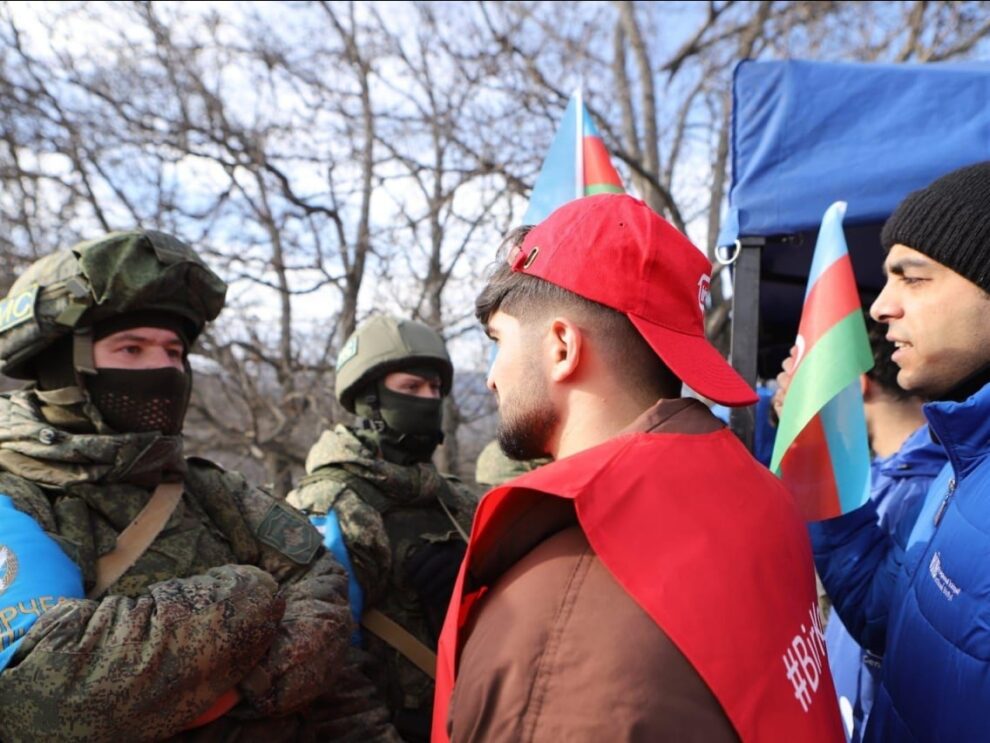“Welcome to Karabakh Telecom. The number you have dialled doesn’t exist,” says an emotionless female voice.
The number belongs to an ethnic Armenian woman stuck in Stepanakert, the now-former de facto capital of Nagorno-Karabakh, a separatist statelet deep in the mountains of Azerbaijan that has not been recognised even by its main backer, Armenia.
The woman’s husband was wounded and suffered heavy burns after a fuel storage exploded on Tuesday and killed dozens near Stepanakert, a city known as Khakendi to Azerbaijan.
A day later, he was flown to Yerevan, the capital of Armenia, but the family is still in Stepanakert amid dire shortages of food, medical drugs and other bare essentials.
“This is a nightmare. It’s just a trap,” the woman’s relative in Ukraine told Al Jazeera.
“All my family – three aunts, their children, grandchildren, my grandfather – are all homeless.”
Also homeless are tens of thousands of ethnic Armenians fleeing Nagorno-Karabakh after more than three decades of its de facto independence, proclaimed on September 2, 1991.

The proclamation followed the first war between two ex-Soviet nations, Armenia and Azerbaijan. It claimed some 30,000 lives and uprooted hundreds of thousands of Armenians and Azeris who mostly fled to Russia.
Armenian and separatist forces seized seven districts surrounding Nagorno-Karabakh that linked the statelet with Armenia and became a no-man’s land dotted with ghost towns and minefields.
The stalemate was written off as one of the former USSR’s “frozen conflicts”, in which the separatists and resource-poor Armenia seemed to be punching well above their military and economic weight.
Triumphant separatist leaders came to power in Armenia, forming a “Karabakh clan” widely accused of corruption that stifled economic growth and foreign investment. They also allegedly misappropriated lavish donations from diaspora Armenians for new weaponry.
After almost three decades of poverty, isolation and flare-ups of violence, the separatists lost the districts and other key areas in a 2020 war with Azerbaijan.
After 32 years and 26 days of unrecognised independence, and one more flare-up earlier this month, Nagorno-Karabakh ceased to exist.
On Thursday, separatist leader Samvel Shakhramanyan signed a decree saying that the region’s state institutions will be dismantled and the statelet, known locally and in Armenia as Artsakh, will be no more by January 1, 2024.
Also on Thursday, David Babayan, Karabakh’s former top diplomat, surrendered to Azeri authorities.
A day earlier, Ruben Vardanyan, an ethnic Armenian who made billions in Russia but moved to Karabakh and served as one of its “ministers,” was arrested and taken to the Azeri capital, Baku.
In Azerbaijan, the news was met with jubilation.
“Today is a historic day, and we have to pay dues to [Azerbaijan’s President Ilham] Aliyev and the Azeri soldiers,” Baku-based analyst Emil Mustafayev told Al Jazeera, adding he thinks the conflict is “definitely” over.
“Today, we are witnessing how separatism ended on Azerbaijan’s territory.”
He said that a “new stage” of development is ahead for Azeris and ethnic Armenians in Nagorno-Karabakh, as the latter were guaranteed full citizenship rights.
“Of course, the beginning will be hard; there’s distrust,” he said. “But I am sure that in 10 years, we’ll observe another picture, with the developed Karabakh and happy Armenians.”
But the overwhelming majority of Karabakh’s Armenians distrust Baku’s pledges.
Thousands of their cars slowly trudge towards Armenia via checkpoints with Azeri servicemen and Russian peacekeepers – and are seen from outer space.
About 85 percent of Nagorno-Karabakh’s ethnic Armenian population – which was 120,000 people strong until last week – has already left, and most of the remaining residents are likely to move, too.
“My aunt is the only one left in her neighbourhood in Stepanakert, her daughter-in-law is a [medical] doctor, and the doctors will be the last to leave,” an ethnic Armenian man now living in Uzbekistan told Al Jazeera.
His father is buried in Stepanakert, and he is ready to host each of his relatives.
He is also adamant that the end of Nagorno-Karabakh’s independence was masterminded earlier this month by the leaders of Russia and Turkey.
The influence of Russia, Turkey
On September 6, Russian President Vladimir Putin welcomed his Turkish counterpart Recep Tayyip Erdogan in the Black Sea resort of Sochi.
Russia has for decades supported Armenia and has close ties with Azerbaijan, while Turkey has strongly backed Azerbaijan, providing advanced weaponry and drones in the 2020 war.
Two weeks after the meeting, four Azeri soldiers and two civilians were killed by landmines that Baku says were planted by separatists.
Azeri troops fought their way into Nagorno-Karabakh, and a day later, the lightning offensive ended as Russia brokered a ceasefire.
“After their meeting, [Azeri forces] were ordered [on Karabakh], were unleashed, and ran after us,” the man said. “Putin let Armenia down, decided to bend it over.”
Analysts pointed to other trends and miscalculations that led to Baku’s triumph.
One of them is demography.
Despite high birth rates, emigration to Armenia, Russia and the West over the years bled dry the Dubai-sized statelet, whose official population peaked at about 140,000.
Armenia’s population also shrank to about 2.7 million, while oil-rich Azerbaijan boasts more than 10 million residents these days.
The number of ethnic Armenians from Syria, who fled the civil war and were given free land in Nagorno-Karabakh, was small and did not reverse the population trend.
“Understandably, even 140,000 could not withstand a much larger and growing population of Azerbaijan,” Nikolay Mitrokhin of Germany’s University of Bremen told Al Jazeera.
The second biggest problem was military.
The separatists, Armenia, and worldwide Armenian diaspora invested little in the construction of the second line of defence installation, especially strongholds in the mountains, Mitrokhin said.
They relied on obsolete stratagems and didn’t take into account new developments battle-tested in the Middle East.
“They badly disguised military equipment, simply didn’t rack their brains about it,” Mitrokhin said about the 2020 war.
“They omitted Baku’s efforts to modernise its military in the 2010s and didn’t buy drones and jeep-mounted mobile artillery units, something that was affordable for Armenia and Artsakh,” he said.
During the 44-day-long war, separatist and Armenian troops moved in large groups or in trucks. Their trenches were wide but shallow, and their artillery and positions stayed put for days, becoming an easy target for drones.
Some observers and Armenian officials claimed that the swarms of drones hitting tanks, missile systems, artillery, trenches and troops were operated from Turkey, and that Ankara allegedly dispatched “mercenaries” recruited in Syria.
Armenian officials and Western media also purported that Turkey deployed thousands of “mercenaries” recruited in pro-Ankara areas of Syria. Azerbaijan and Turkey denied the claims.
The war cost Azerbaijan almost 2,800 soldiers and billions of dollars spent on weaponry.
And, finally, the combined economies of Armenia and Nagorno-Karabakh were too feeble and corrupt to support the military.
“The economy was weak, riddled with crime if not mafia-like,” Mitrokhin said. “Foreign investors, especially those from the Armenian diaspora, didn’t want to invest knowing local mores – or got burned by them, to be more exact.”
Source : Al Jazeera
















